#cacajao
Text

Bald Uakari
105 notes
·
View notes
Photo
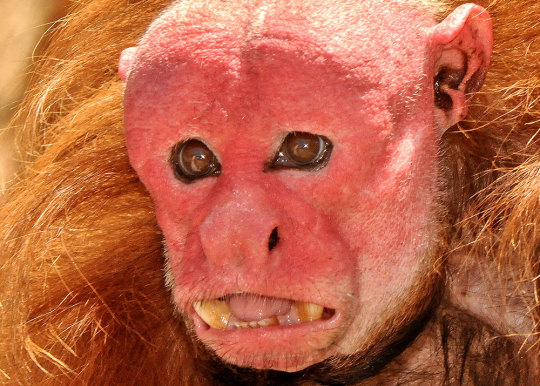
A bald uakari (Cacajao calvus) in Los Angeles Zoo
by Tad Motoyama
#bald uakari#uakari#monkeys#cacajao calvus#cacajao#pitheciidae#simiiformes#haplorhini#primates#mammalia#captive animal#la zoo
18 notes
·
View notes
Text
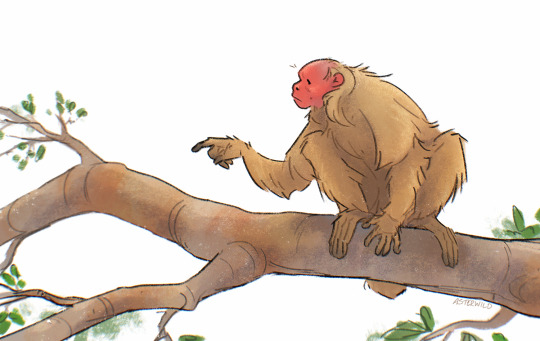
Bald uakari (Cacajao calvus) a New World monkey found in forests of the Amazon river basin in Brazil and Peru.
#id in alt#bald uakari#your suggestions#thanks cartooncreaturelover!#animals#monkeys#primates#wildlife#animal art#digital art#endangered species#while looking for refs i saw an article referring to them as ''the ugliest endangered species you've never heard of'' or something like tha#RUDE.#anyway like to compliment their bald head reblog to smooch their bald head
229 notes
·
View notes
Text
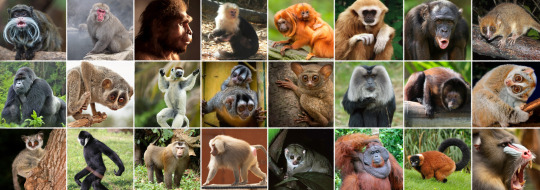
🦍The primate tournament list of candidates has been finalised! Polls will start going up soon!🦧
Thank you to everyone who submitted a species! Here is the full written list:
Basal primates (non-simian primates, including Strepsirrhini and Tarsiiformes)
†Notharctus (Notharctus tenebrosus)
Calabar angwantibo (Arctocebus calabarensis)
West African potto (Perodicticus potto)
Red slender loris (Loris tardigradus)
Bengal slow loris (Nycticebus bengalensis)
Pygmy slow loris (Xanthonycticebus pygmaeus)
Senegal bushbaby (Galago senegalensis)
Brown greater galago (Otolemur crassicaudatus)
Ring-tailed lemur (Lemur catta)
Verreaux’s sifaka (Propithecus verreauxi)
†Archaeoindris (Archaeoindris fontoynontii)
†Megaladapis (Megaladapis madagascariensis)
Madame berthe’s mouse lemur (Microcebus berthae)
Aye-aye (Daubentonia madagascariensis)
Philippine tarsier (Carlito syrichta)
Pygmy tarsier (Tarsius pumilus)
New world monkeys (Platyrrhini)
Wied’s marmoset (Callithrix kuhlii)
Goeldi’s marmoset (Callimico goeldii)
Bearded emperor tamarin (Saguinus imperator subgrisescens)
Golden-headed lion tamarin (Leontopithecus chrysomelas)
Panamanian white-faced capuchin (Cebus imitator)
Central American squirrel monkey (Saimiri oerstedii)
Gray-bellied night monkey (Aotus lemurinus)
Bald uakari (Cacajao calvus)
Madidi titi monkey (Plecturocebus aureipalatii)
Atlantic titi monkey (Callicebus personatus)
Black bearded saki (Chiropotes satanas)
White-faced saki (Pithecia pithecia)
Colombian red howler (Alouatta seniculus)
Brown spider monkey (Ateles hybridus)
Northern muriqui (Brachyteles hypoxanthus)
Yellow-tailed woolly monkey (Lagothrix flavicauda)
Old world monkeys (Cercopithecidae)
Mantled guereza (Colobus guereza)
Zanzibar red colobus (Piliocolobus kirkii)
Nepal gray langur (Semnopithecus schistaceus)
Silvery lutung (Trachypithecus cristatux)
Golden snub-nosed monkey (Rhinopithecus roxellana)
Proboscis monkey (Nasalis larvatus)
Red-shanked douc (Pygathrix nemaeus)
Collared mangabey (Cercocebus torquatus)
Japanese macaque (Macaca fuscata)
Rhesus macaque (Macaca mulatta)
Hamadryas baboon (Papio hamadryas)
Mandrill (Mandrillus sphinx)
Gelada (Theropithecus gelada)
Common patas monkey (Erythrocebus patas)
Bale mountains vervet (Chlorocebus djamdjamensis)
De brazza’s monkey (Cercopithecus neglectus)
Apes (Hominoidea)
Lar gibbon (Hylobates lar)
Pileated gibbon (Hylobates pileatus)
Kloss’s gibbon (Hylobates klossii)
Northern white-cheeked gibbon (Nomascus leucogenys)
Siamang (symphalangus syndactylus)
†Junzi (Junzi imperialis)
Bornean orangutan (Pongo pygmaeus)
†Gigantopithecus (Gigantopithecus blacki)
†Dryopithecus (Dryopithecus fontani)
Western lowland gorilla (Gorilla gorilla gorilla)
Chimpanzee (Pan troglodytes)
Bonobo (Pan paniscus)
†Australopithecus (Australopithecus afarensis)
†Panranthropus (Panranthropus boisei)
†Flores hobbit (Homo floresiensis)
†Neanderthal (Homo neanderthalensis)

The first set of polls will go up as soon as I have finished writing the descriptions! In the meantime, I would appreciate if you could share this tournament around- it won’t be much of a tournament if there aren’t that many people voting! In going down the research rabbit hole I’ve found so many interesting species and stories, and I promise learning about them here will be worth your time!
#primate bracket#tournament#tumblr tournament#poll#polls#primate#primates#extinct primates#biology#animals#zoology#please let me know if I made a mistake anywhere!
99 notes
·
View notes
Text

Bald uakari (Cacajao calvus)
Like… what do I even need to say here? Apparently the bright red face indicates health to potential mates, making the monkeys think it’s hot I guess. They eat fruit and seeds, and are found in seasonally flooded forests of Peru.
#markhors-menagerie#primates#new world monkeys#monkeys#animal facts#fun facts#animals#biology#bald uakari
20 notes
·
View notes
Text
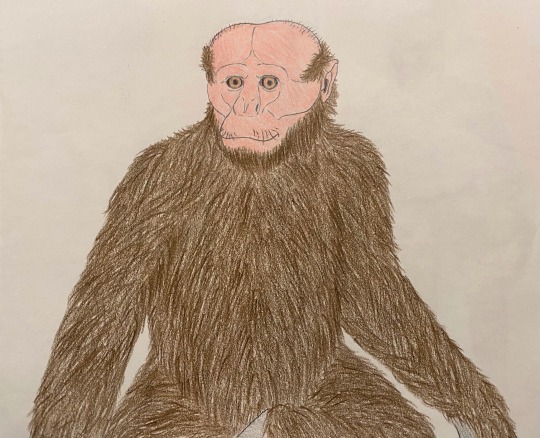
Here’s my rendition of a descendant of the bald uakari (Cacajao calvus) known as the sisimito (Melanopithecus sanguinans), one of the future animals in my Splatoon headcanon! (In my headcanon, nearly all land mammals larger than a cat went extinct, but some smaller land mammals survived) Like its close relatives in the Calvopithecinae subfamily, it is robust in build and convergent with apes, which have been reduced to a few species in the mollusc era.
The original concept credit goes to -casu on Reddit.
#speculative evolution#speculative biology#future evolution#splatoon headcanon#splatoon#splatoon 2#splatoon 3#speculative zoology
5 notes
·
View notes
Text
Northern Bald Uakari
Deep within the lush, untamed realms of the Amazon rainforest resides a creature of remarkable peculiarity and charm – the Northern Bald Uakari (Cacajao calvus rubicundus). This extraordinary primate, distinguished by its vivid red face, striking bald head, and haunting golden eyes, epitomizes the enigmatic biodiversity that thrives in the heart of South America. Despite its captivating…

View On WordPress
0 notes
Text

I would like everyone to know I have unlocked a new fear in life. These things… Scientific name is the “Cacajao” commonly the Uakari, but can also be referred to as “the Englishman” due to the bald red face (sorry English people). Like no doubt they’re very polite, but sorry that’s a living nightmare creature. I am afraid.
0 notes
Photo

「俺、結構酒強いよ。今日はとことん飲むよ」って誰も頼んでないのに宣言した人が、二杯目くらいに顔が「ウアカリ」みたいになってると、いつ吐くのか心配になっちゃって全然楽しめないからとにかく無理しないでほしい
飲み屋で確かにこんな顔の人いるw このおサルさん初めて知ったけど、残念ながら日本の動物園にはいない模様。
2 notes
·
View notes
Photo


Uakari
Genus: Cacajao
Particularly sinister looking, their name is not of the same ilk – meaning ‘Dutchmen’ in the local language, this is said to be because their bright red faces reminded the locals of the sunburnt faces of European tourists.
Similar to Saki monkeys in the the food that they eat, they differ in how they move, as Uakaris can leap up to an astonishing 20 feet.
8 notes
·
View notes
Note
Thoughts on uakari? I love how weird they look - like something from a dark fantasy movie :3
My thoughts are:
I LOVE THEM
youtube
They are so unique visually; They also have unique dentition that allows them to eat unripe fruits other Latin American monkeys can't eat!

Via Science Direct
90% of their diet consists of fruits and flowers. Their groups can consist of a pair up to hundreds of individuals; Larger groups are seen when food is more abundant. Groups are typically evenly divided male/female. Little is known about uakari as they have been studied very little in the wild. Captive troops are hierarchal but wild troops seem to be less strictly tiered. They wag their tail quite frequently and it is believed a lifted tail communicates excitement while a lowered tail communicates apprehension.
Cacajao calvus are the bald uakari, but
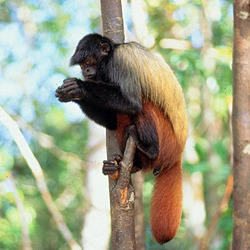
C. melanocephalus has plenty of hair
Little is known about their wild populations and their conservation status is not decided currently. Right now, they are listed as least concern but some believe the numbers are not accurate. They are targets of poachers for their skulls and body parts to sell to tourists, they are also captured for the pet trade. Threats to their habitat are of concern as well, like many tropical species.
Sources X
57 notes
·
View notes
Text

A Red bald-headed uakari feeding on a fruit in the Amazon ecosystem, Brazil.
The bald uakari (Cacajao calvus) or bald-headed uakari is a small New World monkey, native to the Western Amazon (Peru, Brazil and possibly Colombia). It normally grows to 14 - 22.5 in (35-57 cm), and weighs between 4 - 7 lb (1.8 - 3.2 kg). This primate is recognised by its short tail, bright crimson face, a bald head and long coat which range from blonde to orange to brown or red in color.
The striking scarlet red face is due to the blood flow under its facial tissue, specifically a thinner epidermis coupled with a higher concentration of capillaries in the face. While the female's face redness is associated with estrogen levels, that of the male's is indirectly related to his testosterone levels. Also, a redder face indicates a healthier monkey, which, similar to us humans, grows pale when the animal is ill.
📷 claus meyer
www.naturepl.com/search?s=claus+meyer
Info sources: www.neprimateconservancy.org, wikipedia
13 notes
·
View notes
Text










Tagged by @arthriticserpent ! Ten photos of pics you already have saved in your phone that best represent yourself. I don’t think there’s a rule against selfies but it’s much funnier without them.
I tag @comic-books-and-bars @octovolve @teethingviolets @cacajao @papiwolves
5 notes
·
View notes
Text
Round 1, part 1, match 12: oddball monkeys
Gray-bellied night monkey (Aotus lemurinus)

Night monkeys are a rather odd group; while most monkeys are active in the daytime, night monkeys are nocturnal. Their huge eyes let them see even in the dark, and they have given up the colour vision otherwise common in monkeys. Gray-bellies are found in forests across the eastern edge of the Northern Andes. They eat mostly fruit, but also small animals.
Bald uakari (Cacajao calvus)

Like… what do I even need to say here? Apparently the bright red face indicates health to potential mates, making the monkeys think it’s hot I guess. They eat fruit and seeds, and are found in seasonally flooded forests of Peru.
21 notes
·
View notes
Text
Planned road to bisect pristine, biodiverse Brazilian Amazon national park

On the western edge of the Brazilian Amazon, a makeshift dirt road slices through dense rainforest. Along some stretches, the green canopy flanking the roughly-carved road gives way to open sky, felled trees and piles of neatly cut timber. It halts abruptly at the doorstep of Serra do Divisor National Park in Acre state, beyond which untouched forest sprawls over thousands of hectares to the Peruvian border.
The stretch of improvised road, which local sources estimate at roughly 20-30 kilometers in length, was carved out in recent months and appears to mark a first step in the construction of a proposed national highway project. When — or if — completed, it will stretch from Cruzeiro do Sul, in the Brazilian state of Acre, to the city of Pucallpa, in the Peruvian Andes.
The branch road — not yet officially approved by authorities — would extend the already lengthy BR-364, a highway that winds some 4,325 kilometers (2,687 miles) across Brazil, starting in São Paulo and currently ending in Acre. The new branch road would run another 152 kilometers (94 miles), cutting through Serra do Divisor, a national park federally protected since 1989 and known for its spectacular biodiversity.
The protected area spans some 846,633 hectares (2.09 million acres), and boasts thousands of plant and animal varieties, including threatened species like the White-uakari (Cacajao calvus calvus), a small New World monkey, and the Yellow-spotted river turtle (Podocnemis unifilis). Some, like the Acre antshrike bird (Thamnophilus divisorius) are relatively new to science (discovered in 1996); it is thought to be endemic only to Brazil’s Serra do Divisor and the adjacent Sierra del Divisor National Park in Peru.
Supporters of the new road tout it as a crucial commercial link, promising it will boost Brazil’s trade with its Andean neighbor and allow Brazil to more easily export products to Asia via Peru and the Pacific Ocean. But critics warn its construction will deal a devastating blow to the national park and the Indigenous people who call this untrammeled area home.
A key concern: The new highway will open up access to this remote portion of the Amazon rainforest as never before, potentially paving the way for a flood of loggers, cattle ranchers and landgrabbers into a mostly untouched region.
Continue reading.
#brazil#brazilian politics#politics#environmentalism#environmental justice#transportation#indigenous rights#mod nise da silveira
7 notes
·
View notes

